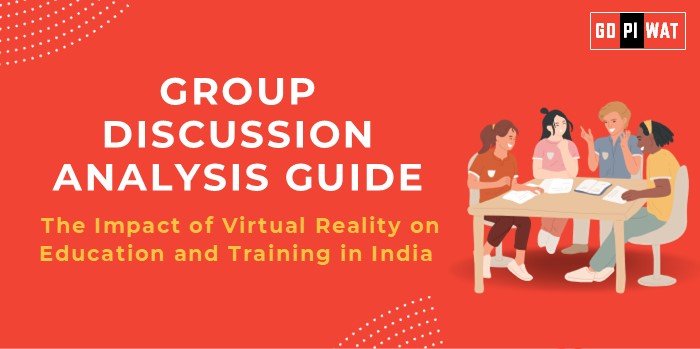📋 Group Discussion (GD) Analysis Guide: The Impact of Virtual Reality on Education and Training in India
🌐 Introduction to the Topic
Virtual Reality (VR) is revolutionizing education and training globally, offering immersive and interactive learning experiences. In India, with a burgeoning EdTech sector and government emphasis on digital transformation, VR is poised to bridge gaps in education quality and access. This discussion explores its current role, potential, and challenges.
📊 Quick Facts and Key Statistics
- 📈 Indian EdTech Market Size: Expected to reach $10.4 billion by 2025, with VR contributing significantly.
- 👨🎓 Student Population: Over 250 million students, providing a vast potential audience for VR applications.
- 🇮🇳 Government Initiatives: Programs like PM eVidya promote tech integration in education.
- 🌍 Global VR Market Growth: Projected to grow at a CAGR of 18.2% from 2024 to 2032, indicating increasing adoption in education worldwide.
👥 Stakeholders and Their Roles
- 🏛️ Government: Policy frameworks and funding (e.g., Digital India, Skill India).
- 💻 Private Sector: Development of VR hardware and content (e.g., BYJU’s, Tesseract).
- 🏫 Educational Institutions: Integration of VR in curricula and infrastructure.
- 👩🎓 Students and Trainees: Primary beneficiaries of immersive learning methods.
🏆 Achievements and Challenges
Achievements
- ✨ Skill Development: VR enables experiential learning for vocational training.
- 🏡 Accessibility: Rural outreach through cost-effective VR kits.
- 🎨 Customizable Content: Industry-specific training modules are widely available.
Challenges
- 💰 High Costs: VR equipment remains expensive, limiting scalability.
- 🌐 Infrastructure Gaps: Poor digital connectivity in rural India.
- 🧑🏫 Digital Literacy: Lack of teacher training for VR tools.
🌍 Global Comparisons
- 🇺🇸 USA: VR aids medical training with simulators like Osso VR.
- 🇨🇳 China: Integrating VR in primary education through national programs.
📚 Case Studies
- 📍 Kerala’s VR Labs: Effective use of VR for skill development in ITIs.
- 📍 IIT Bombay’s XR Lab: Research on VR in engineering education.
💡 Structured Arguments for Discussion
- ✅ Supporting Stance: “VR can democratize quality education in India, bridging the urban-rural divide.”
- ❌ Opposing Stance: “High costs and infrastructure issues hinder VR’s widespread adoption.”
- ⚖️ Balanced Perspective: “While VR is transformative, its success depends on cost reduction and policy support.”
🛠️ Effective Discussion Approaches
- 📊 Opening Approaches:
- “India’s EdTech market is booming at $10 billion, and VR is at the forefront.”
- “Kerala’s VR initiatives demonstrate how VR can enhance vocational training.”
- 🛡️ Counter-Argument Handling: “While costs are high, partnerships with startups can make VR more affordable.”
🔍 Strategic Analysis (SWOT)
- 💪 Strengths: High engagement potential, scalable content.
- ❌ Weaknesses: Limited affordability and access.
- 🌟 Opportunities: Public-private partnerships, affordable hardware solutions.
- ⚠️ Threats: Resistance to adoption, lack of teacher training.
📖 Connecting with B-School Applications
- 🎓 Real-World Applications: VR use in management simulations and organizational training.
- 💬 Sample Interview Questions:
- “What role can VR play in bridging India’s educational divide?”
- “How does VR compare with traditional e-learning platforms?”
- 🔎 Insights for Students: Explore VR applications in finance, healthcare, and operations.


